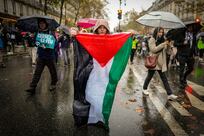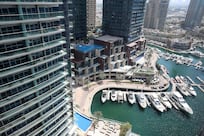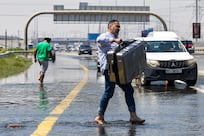Witness accounts and satellite photos released by the Arab Coalition supporting Yemen's government have provided further confirmation that Houthi rebels were responsible for the deadly attack on a hospital and fish market in Hodeidah city on Thursday.
The satellite images of the area before and after the attack show that the damage to Al Thawra Hospital and market was the result of mortar strikes, a coalition source said.
"Contrary to initial media reports and Houthi claims that attributed responsibility to coalition air strikes, the available evidence clearly demonstrates that the damage resulted from mortar shells fired from an area close to the impact sites," he told the UAE state news agency, Wam.
The coalition has already said it did not carry out any operations in Hodeidah on the day of the attack.
The satellite images released by the coalition show impact craters of about 50 centimetres, whereas the minimum impact area from an air strike is three metres.
Rashed, a resident of Hodeidah who said he went to the hospital as soon as he heard the reports of coalition air strikes, told The National the blast craters were much smaller than he had expected.
"I was expecting to see the big craters usually left by air strikes, but as soon as I arrived at the scene of the attack I was certain it was not carried out by coalition aircraft. I found shrapnel from mortar shells, which indicated that the attack was from the ground not from the sky," he said.
When he pointed this out to the Houthi fighters guarding the hospital gates, he was ordered to leave the area, he said.
Mohammed Abdullah, another Hodeidah resident, said he saw unexploded mortar shells and fragments at the hospital and the fish market.
"As soon as I arrived outside the hospital I found the Houthi news channel Al Masirah broadcasting live. I wondered how they had arrived so fast with all their equipment. Then I entered the hospital records office, whose roof was pierced, and saw a mortar shell that had not exploded," Mr Abdullah said.
He said there were also many shell fragments outside the hospital, while the Houthis gave conflicting accounts of the attack. "Sometimes they said the shelling was carried out by coalition aircraft, other times they said the shelling was carried out by warships from the sea," he said.
_____________
Read more:
[ Yemen’s fight against the Houthi landmine legacy ]
Yemen calls for sustained political pressure on Houthis before proposed Geneva talks
Yemeni blacksmiths beat shrapnel into daggers
_____________
Other Hodeidah residents, who asked to not to be named, said they heard mortars being fired from a rebel base near the hospital just before the news broke of the attack.
The attack came on the same day as the planned launch of a cholera vaccination drive, and hours before the UN special envoy for Yemen briefed the Security Council in New York, where he presented plans to resume peace talks next month.
Yemen's Minister for Human Rights Mohmmed Askar said it was timed to gain sympathy from the Security Council.
The government had established that the attack was carried out by Houthis firing mortars from nearby areas, with 14 people dead and 30 others injured, Mr Askar told The National.
"This crime is not the first one committed by the Houthi militias against civilians in Hodeidah or elsewhere by indiscriminate bombing of residential neighbourhoods," he said.
Mr Askar listed several previous rebel attacks on civilians in the city and elsewhere in Hodeidah province, including the shelling of a residential area near the airport in Wadi Al Aqoum on July 19 that killed seven civilians and injured 10 others, and the bombardment of Al Tuhaita city with dozens of missiles on the same day, killing 14 civilians.
On July 22, the rebels killed two people and injured 31, most of them children, when they shelled a drinking water distribution point in the Bani Bakr neighbourhood of Hays city, south of Hodeidah.
The rebels shelled areas near the airport again on June 27, Mr Askar said, killing six people and injuring more than 15, including children.





